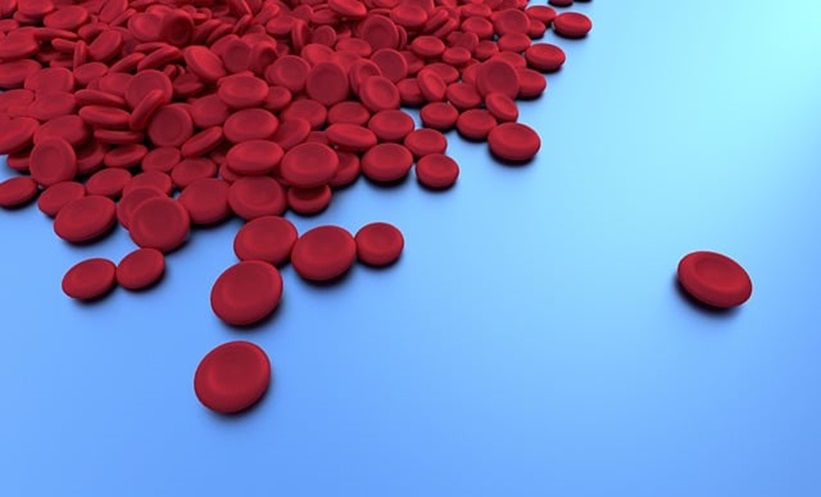The magnificent city of Madrid, Spain, welcomed this year’s annual European Association of Hematology (EHA) meeting, held from 22nd–25th June 2017. As Europe’s largest organisation for haematologists, EHA has a number of goals that it sets out to achieve, which include improvements in research environments, the promotion of greater research funding, and to increase access to haematology care across Europe. Educational programmes are highly celebrated, as EHA believes the quality of science being transferred to young haematologists is of paramount importance. To support this, training programmes, career support, and education is available for all who attend, helping to secure the future of haematology.
Nearly 11,000 delegates from >120 different countries all around the world joined us in Madrid to help celebrate haematology. This year, a record-breaking number of abstracts were submitted, totalling a whopping 2,500. The latest basic, clinical, and translational research was shared throughout 240 different sessions, offering an insight to knowledge that directly impacts clinical practice. The educational programme included nearly 60 different talks scattered throughout the event. As always, this year’s EHA organisers fulfilled their promise by providing a vast array of topical sessions and knowledge for all who love haematology.
Find the main highlights of EHA in our congress review section, where you will also be presented with a number of different abstracts investigating topics such as myeloproliferative neoplasms and lymphocytic leukaemia, to give you a feel for some of the research presented. The chair of the scientific programme committee and advisory board of EHA, Prof Shia Izraeli, commented: “I and EHA are convinced that research lies in the heart of haematology. Therefore, our main goal in generating this scientific programme is to bring you the best of research. The best of basic research, translational research, clinical research, in all areas of haematology. Research that puts the patients in the middle. Research’s ultimate goal, even the basic goals of research, is to make discoveries that change life; to make discoveries that improve the lives of our patients.”
During the opening ceremony, a 1-day young EHA research meeting was introduced, which will be organised by young haematologists from the region in which the congress is held. Occurring on the Thursday before every annual congress, postdoctoral and PhD student speakers will be featured. An incredibly interesting and informative presentation was conducted by Rudd Delwel, which discussed the negative side of gene regulation with regards to acute myeloid leukaemia (AML), as well as the enhancers in the pathogenesis of AML. A number of awards were also given, to celebrate the success and developments that have been made in the past year, which included clinical research grants, clinical advanced research grants, non-clinical junior research grants, and short-term collaboration awards.
As always, EHA delivered an impeccable collection of high-quality symposia, providing pharmaceutical companies with a platform to share their cutting-edge research and developments with the world.
We hope that you will enjoy reading our congress review section, and that you find it informative, interesting, and thought-provoking. If you were unable to attend this year’s EHA congress, we hope to provide you with all the information you missed out on, and if you were one of the 11,000 lucky enough to attend, we hope this serves as an accurate guide for you to reflect on. EHA’s burning desire to help the future of haematology progress and develop is highly contagious, and we cannot wait to see the research that will be shared at next year’s congress in Stockholm, Sweden. We hope to see you there!
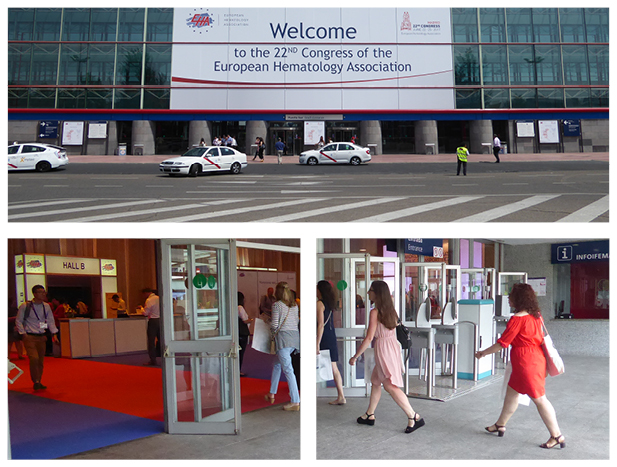
Reversible RhoA and Rac Inhibitors: The Key to Platelet Storage Lesion Prevention?
TARGETED intervention using specific GTPase inhibitors can prolong the shelf-life of platelets in refrigerated storage, due to their ability to prevent platelet lesion, according to a EHA press release, issued 23rd June 2017. The study researchers found that by using reversible RhoA and Rac inhibitors, it was possible to prevent activation of RhoA and Rac GTPase proteins, which are responsible for cell lesion activity in cold storage.
Allogeneic platelet transfusion is necessary for the prevention and treatment of bleeding in haemorrhagic and thrombocytopenic patients. Routinely, platelets for transfusion are stored at room temperature, as refrigeration results in alterations in the platelet cell membrane microdomains, leading to complex molecular lesions, which are then recognised by macrophage cells and hepatocyte counter-receptors. This recognition leads to clearance of the platelets, post-transfusion. However, room temperature does not come without its limitations, as it poses an increased risk of bacterial contamination, restricting the overall shelf-life of stored platelets to 4–6 days.
The study’s aim was to prevent refrigeration-induced cell lesion and prolong the validity of platelets stored in cold conditions. Platelets were isolated from anticoagulated human, Rhesus monkey, and murine whole blood. RhoA, Rac, and Cdc42 inhibitors (G04 [75 mcM], NSC23766 [50 mcM], and Casin [10 mcM], respectively) were used. RhoA-deficient murine platelets were sourced from poly:C-treated Mx1-Cre;RhoA f/f mice. The transfused platelets were stored in either plasma (33%) or PAS-III (67%) at room temperature or at 1–9°C, for 7 days, or 1–4 hours for murine platelets. Results demonstrated that short and long-term refrigerated storage activated both RhoA and Rac1, but did not affect Cdc42. The inhibition of RhoA with G04 prevented refrigeration-induced platelet clearance after long-term storage of human and murine cells.
Future studies will likely be aimed at determining the validity of the method for human allogeneic transfusion, to determine its viability and potential as an alternative to pathogen reduction methods.
JULIET Study Confirms Efficacy of CTL019 for Treating Lymphoma
DURABLE remissions of relapsed or refractory (r/r) diffuse large B-cell lymphoma (DLBCL) could result from treatment with CTL019, suggested the results of the JULIET trial in a EHA press release dated 24th June 2017. This global trial represents a confirmation of previous findings in a single-centre study, showing that CTL019, a chimeric antigen receptor (CAR) T cell therapy, can produce a high rate of durable complete responses (CR).
This experiment provided CAR T cells to adult patients from 27 centres, in 10 countries, from 4 continents. The study’s primary endpoint was to find the best overall response rate (ORR), a combination of CR and partial responses (PR). In the trial, 85 patients with r/r DLBCL, all of whom had undergone extensive pre-treatment for the condition, received a single dose of CRL019 transduced cells. Within that cohort, 51 patients with ≥3 months follow-up or earlier discontinuation produced promising results; ORR was 59%, with 43% of those achieving CR (95% confidence interval: 44–72%). All the patients who had achieved CR at 3 months remained so until the end of the trial.
In treated patients, 57% and 26% developed all-grade and grade 3 or 4 cytokine release syndrome, respectively, although no cytokine release syndrome-related deaths were noted. Overall, no fatalities were attributed to the CRL019 treatment, which was generally well-tolerated by the subject group.
The results of this trial indicate the next step towards the verification of this ground-breaking therapy. The authors note the feasibility of centrally manufacturing the autologous T cells used in the treatment and suggest that this treatment has the potential to widely impact the clinical treatment of DLBCL.
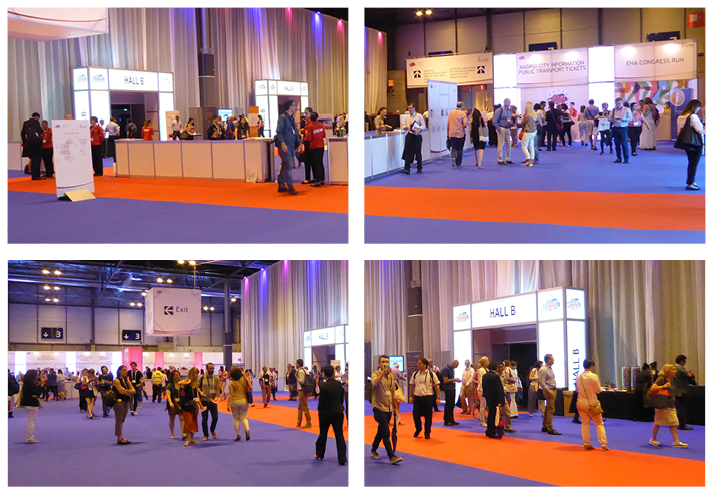
Common Infections Can Cause Childhood Acute Leukaemia
EXPOSURE to common infections could play a crucial role in the development of acute leukaemia in children, according to a EHA press release dated 23rd June 2017. The study reported here provides a rare and pivotal opportunity for developing novel approaches for the prevention of acute leukaemia, which is currently the most common childhood cancer.
Lead presenter, Dr Julia Hauer, Clinic for Pediatric Oncology, Haematology and Clinical Immunology, Düsseldorf, Germany, and colleagues exposed genetically engineered mouse models to a common infection environment before using whole exome sequencing and whole genome sequencing to investigate the molecular characteristics of B cell precursor acute lymphoblastic leukaemia (BCP-ALL) development. The team used Sca-1, a stem cell antigen, to direct expression of two common subtypes of BCR-ALL (BCR-ABL1p190 and ETV6-RUNX1) in addition to using a Pax5+/- model with subsequent loss of the Pax5 transcription factor function.
Researchers discovered that the Pax5+/- and Sca-1 ETV6-RUNX1 mice developed BCP-ALL only after exposure to common pathogens and that genetic predisposition played a role in the molecular mechanism. The activation of JAK3 mutations in B cell precursors were responsible for BCP-ALL development in the Pax5+/- mice, whereas high expression of Recombination Activating Gene 1 and loss of function mutations in Ebf1, both of which have been previously correlated with human ETV6-RUNX1 leukaemia, were found in the Sca1-ETV6-RUNX1 mice. In contrast, BCR-ABL1p190 mice developed BCP-ALL as a result of reprogramming a haematopoietic stem or progenitor cell, initiating loss of Pax5, without exposure to pathogens.
This study confirmed that the development of childhood BCP-ALL by Pax5 loss of function or ETV6-RUNX1 modification can be prompted by exposure to common infection, due to a genetic predisposition in these children. However, when an oncogene is responsible for the development of BCP-ALL, this occurs without exposure to infection. Researchers hope these findings will help encourage novel interventions to prevent or treat many cases of childhood BCP-ALL.
Diverse T-Lymphocytes are Better at Fighting Leukaemia
HIGH remission rates have been shown in adult patients with refractory or relapsed (r/r) B-cell acute lymphoblastic leukaemia (r/r ALL) receiving blinatumomab (Blin), as reported on 23rd June 2017 in a EHA press release. Blin, a bispecific T cell engager (BiTE®), is an antibody developed to direct cytotoxic T cells to CD19-expressing B cells. Although Blin has been reported to be successful in reducing reported anti-tumour activity in r/r ALL patients, minimal residual disease (MRD) is not achieved by approximately half of these patients.
Researchers aimed to compare two groups, responders and persisters, to investigate the differences in TRβ gene diversity and composition. Responders were those who were MRD negative by C1D29 (Day 29 of one Blin cycle), whereas responders were either those with quantifiable MRD positivity at C1D29, or >1% MRD at C1D15. To do this, they used next-generation sequencing to study TRβ repertoire in bone marrow sampling in 114 r/r Ph-negative BCP-ALL patients (114 x at screening time, 74 x C1D15, 98 x C1D29). The median age of persisters used was 47, and the corresponding age for responders was 42 (p=0.81). In this Phase II trial, patients were administered Blin, and 100 ng of DNA was prepared on the Illumina MiSeq (2 x 250bp), by sequencing libraries via two-step PCR, with a mean coverage of 117,563 reads. A significant amount of TRβ rearrangements that were presented in the investigated sample were amplified in the first PCR through the use of universal V(D) and J-regions primers. Sample specific barcodes and sequencing adaptors were added during the second stage.
Responders demonstrated an increased diversity of TRβ variation at the time of screening (p=0.02) and at C1D29 (p=5.47E-6). The diversity between screening and C1D29 of Blin treatment in responders was shown to be significant and sharp (p=3.96E-6); it was not statistically significant in persisters (p=0.4), yet they did have a significantly higher blast count. Although further research is needed with a larger patient cohort, researchers demonstrated that Blin persisters had a lower TRβ repertoire diversity at screening compared to responders.
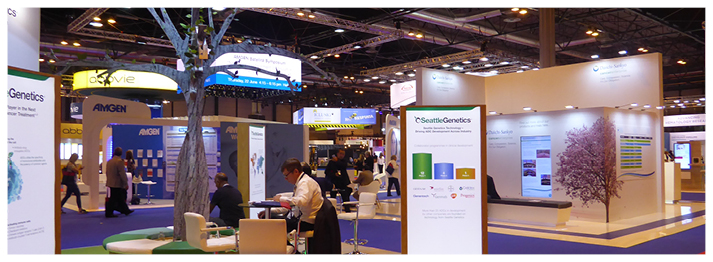
Ibrutinib Performs Well for Treating Chronic Graft Versus Host Disease
PATIENTS undergoing allogeneic stem cell transplantations have a high risk of developing chronic graft versus host disease (cGVHD), a life-threatening complication that has no approved therapy options after the failure of steroid treatment. In a press release presented at the EHA congress on 24th June 2017, researchers from the Washington University School of Medicine, St. Louis, Missouri, USA, unveiled their positive findings regarding the use of ibrutinib to treat cGVHD.
The pathophysiology of cGVHD is related to the activity of T and B cells, and recent studies have shown that ibrutinib, a Bruton’s tyrosine kinase inhibitor, is effective at inhibiting not only B cells, but also specific subsets of T cells. Treatment with ibrutinib in mouse models yielded positive results, reducing both the progression and severity of the condition; therefore, a multicentre human trial was organised.
The trial selected 42 patients with steroid-dependent/refractory cGVHD who had undergone ≤3 treatments. Following a daily dose of ibrutinib (420 mg), researchers recorded an overall response rate of 67% (21% complete response) at a median follow-up of 13.9 months, with 71% showing a sustained response of ≥20 weeks. Following these positive results, corticosteroid doses were reduced in most responders, with 5 ending their corticosteroid treatment altogether. Serious adverse events were recorded in 52% of patients, with 40% of patients reporting Grades 1–3 adverse events.
The high response rate in this pre-treated, high-risk population suggests that ibrutinib could be a promising treatment option for patients with cGVHD, especially those who did not see positive results from previous therapy. The researchers are confident that further studies will be undertaken to verify the efficacy of this drug as a front-line treatment.
Rapid Tumour Responses Observed Using Dual Syk-JAK Inhibitor in r/r B Cell Malignancies
A PHASE II study has shown that an oral dual Syk-JAK inhibitor has the ability to inhibit two key cancer cell growth promoting (in certain haematological malignancies) signalling pathways. These pathways, namely the B cell receptor pathway via Syk, and the cytokine receptors via JAK, are responsible for increasing cancer cell growth in specific haematological malignancies. Preclinical research advocates the potential anti-tumour properties of this inhibitor, in patients with relapsed or refractory (r/r) malignancies. These results were shared in a EHA press release, issued 23rd June 2017.
Interim results from the safety and efficacy study, initiated in May 2016, evaluated the use of the inhibitor in patients diagnosed with specific types of non-Hodgkin lymphoma (NHL). The study design is for ≤40 patients to be enrolled in each of three cohorts: r/r chronic lymphocytic leukaemia / small lymphocytic lymphoma (CLL/SLL [currently 17 patients enrolled]); r/r indolent NHL (iNHL [currently 15 patients enrolled]); relapsed diffuse large B-cell lymphoma, mantle cell lymphoma (MCL), and transformed follicular lymphoma (FL) (currently 5 patients enrolled). This is an open-label study with 28-day cycles. The interim results demonstrated that the inhibitor was generally well-tolerated in most patients despite patients being heavily pre-treated. The Syk and JAK signalling pathways were significantly inhibited in peripheral blood.
To date, overall response rates include partial responses in patients with r/r CLL/SLL (12/18 [67%]), partial responses in patients with r/r FL (5/9 [56%]), and partial responses in patients with r/r iNHL (1/7 [14%]); a complete response was observed in the first r/r peripheral T cell lymphoma patient. It should be noted that 3 patients on a twice daily dose of 35 mg experienced severe adverse events (2 cases of Grade 5 infection, 1 case of Grade 3 pancreatitis) and a higher than expected drug concentration. The dose was reduced in these patients to 30 mg twice- daily and pharmacokinetics were measured.
On completion of the study, updated pharmacokinetic and pharmacodynamic data, and safety and efficacy profiles will be presented. In the interim, the initial results indicate the clinical activity of the generally well tolerated dual Syk-JAK inhibitor.
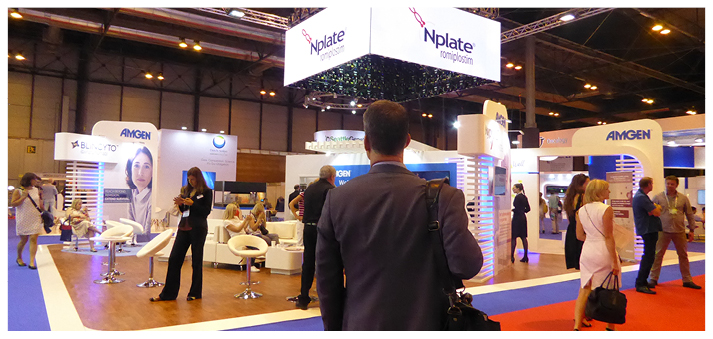
Pioneering Trial of Axicabtagene Ciloleucel in Non-Hodgkin Lymphoma Patients
IMPROVED objective response rate (ORR) for refractory aggressive non-Hodgkin lymphoma (NHL) after treatment with axicabtagene ciloleucel (axi-cel) during the pioneering ZUMA-1 study were presented by Dr Yi Lin, Mayo Clinic, Rochester, Minnesota, USA, at this year’s EHA conference, reported in a press release dated 24th June.
Outcomes for patients with refractory aggressive NHL remain poor with existing therapies. During this study, the effects of axi-cel, an anti-CD19 chimeric antigen receptor T cell therapy, were assessed. ZUMA-1 was the first multicentre trial of axi-cel for refractory, aggressive NHL. This Phase II trial involved 101 patients with diffuse large B-cell lymphoma, primary mediastinal B-cell lymphoma, or transformed follicular lymphoma. After conditioning with low-dose cyclophosphamide and fludarabine, all patients received axi-cel at a target dose of 2×106 cells/kg.
The primary endpoint of the ZUMA-1 trial was achieved, with the objective response rate of a combined population of 82% (n=92; p<0.0001). These results were consistent across patient subgroups including disease subtype, refractory status, and disease stage. The median duration of response was 8.2 months, but this was not reached by patients who achieved complete response (CR) (54%). Overall survival (OS) was not achieved for all patients, with 80% of patients still alive at 6 months. The CR of this study was seven- times higher than in historical control studies. After a median follow-up of 8.7 months, almost half of the patients had an ongoing response.
Adverse effects reported during the trial included neutropenia (66%), leukopenia (44%), anaemia (43%), febrile neutropenia (31%), and encephalopathy (21%). Additionally, Grade ≥3 cytokine release syndrome and neurologic events occurred in 13% and 28% of patients, respectively.
The study concluded that axi-cel offered improved ORR in patients with refectory NHL. Axi-cel demonstrated significant clinical benefits with a manageable safety profile in patients with limited treatment options.
Assessment of Early Metabolic Response in Hodgkin Lymphoma Patients
A RAPID response to chemotherapy may warrant a substantial reduction in overall treatment intensity for patients with advanced stage Hodgkin lymphoma (HL). This is according to a EHA press release dated 24th June 2017. Currently, 6–8 cycles of eBEACOPP (dose-escalated bleomycin, etoposide, doxorubicin, cyclophosphamide, vincristine, procarbazine, and prednisone) is a highly effective treatment for advanced-stage HL but has severe toxicities. Numerous HL patients may benefit from the reduced toxicity associated with less intense chemotherapy; however, it is currently not possible to identify these patients using the international prognostic score.
Dr Peter Borchmann, Uniklinik Köln, Cologne, Germany, and colleagues conducted the GHSG HD18 Trial in five European countries, involving 2,101 advanced-stage HL patients, of whom 1,005 patients were PET-2 negative. Defined as having a fluorodeoxyglucose (FDG) uptake that was not higher than the mediastinal blood pool after two cycles of positron emission tomography, the PET-2 negative patients therefore had a rapid metabolic response to treatment. Treatment of patients was randomised with 504 receiving the treatment of six or eight cycles and 501 receiving eBEACOPP trialled four cycles of chemotherapy.
After 55 months, estimated progression-free survival in the subset given eight cycles of eBEACOPP was quantified as 90.8%, compared to a higher result of 92.2% in patients given four cycles (difference +1.4%; 95% confidence interval: -2.7–5.4). In addition, no patient in the experimental group died from treatment-related toxicities and the team observed lower severe infection rates (15.0% versus 8.0%), reduced organ toxicities (18.0% versus 8.0%), and a lower incidence of second malignancy in this group (11 patients versus 1 patient). Overall, these results led to a significant difference of 2.3% in 5-year overall survival, which was 95.4% in the six-cycle group compared to 97.7% in the four-cycle group (log-rank p=0.004).
Dr Borchmann and colleagues concluded that eBEACOPP therapy can be reduced from six cycles to four cycles following assessment of metabolic response using FDG-PET. In addition, patients given four cycles of therapy, compared to the standard regimen, experienced improved tolerability, resulting in a significant improvement of overall survival, and therefore the team recommend this approach for the treatment of advanced-stage HL patients.
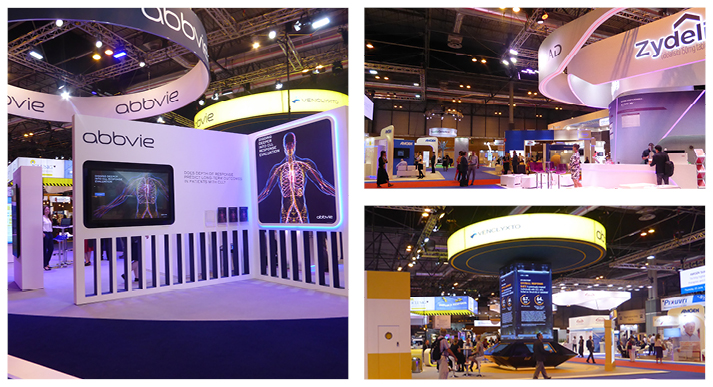
Anticoagulant Treatment of Venous Thrombosis in Cancer Patients
RISK of blood clots in the legs or lungs, termed venous thromboembolism (VTE), is increased in cancer patients. The risk of bleeding is also increased in cancer patients due to abnormal tumour anatomy and the use of chemotherapy agents, among other factors. The typical treatment for VTE is the prescription of anticoagulants, although these result in an increased bleeding risk.
This study, reported in a EHA press release dated 24th June, assessed the risks and benefits of using anticoagulants for cancer patients with VTE, to facilitate better-informed treatment for patients at a high risk of both VTE and major bleeding (MB) events.
A retrospective population-based cohort study was carried out using healthcare databases at the Institute for Clinical Evaluative Sciences (ICES), Toronto, Canada. Patients >65 years old with a diagnosis of cancer according to provincial, ICD-9, and ICD-10 codes for major malignancies who developed VTE within 6 months of the initial cancer diagnosis were included. VTE and MB were identified using previously validated algorithms. Treatment was determined based on the first available anticoagulant prescription.
A total of 6,967 VTE events were identified in this study. The mean age of patients was ˜75 years (47.6% patients were female). Patients received several different prescriptions: 59.9% received low molecular weight heparins, 15.3% received low-molecular-weight heparins and warfarin, 22.1% received warfarin, and 2.7% rivaroxaban. At 180 days after VTE events, 235 (3%) MB events and 1,184 (17%) incidences of VTE recurrence were recorded. Within 7 days of outcome events, there were 26 (11%) deaths after MB and 6 (0.5%) after VTE. These results gave a mortality ratio for MB versus VTE of 21.8 (95% confidence interval: 9–53). No variation was found between anticoagulants.
This study has shown that in cancer patients >65 years old who were treated with anticoagulants for VTE, the 7-day mortality after a MB event was at least nine-times higher than after a VTE recurrence. Further research is required to validate the study, but this finding should be considered during current treatment decisions.
Treatment of Sickle Cell Disease and Beta-Thalassaemia Using CRISPR/Cas9 Gene Editing
GENE editing using CRISPR/Cas9 efficiently enabled researchers to recreate the small DNA changes responsible for hereditary persistence of fetal haemoglobin, (HbF) leading to the protective expression of HbF, reducing symptoms in sickle cell disease and beta-thalassaemia patients. The results were reported in a EHA press release issued on 23rd June 2017.
Sickle cell disease and beta-thalassaemia result from faults in the beta-globin protein found within erythrocyte haemoglobin. Initially, patients born with these conditions do not present with symptoms, as their erythrocytes contain a protective protein, known as fetal gamma globin, within fetal haemoglobin. Symptoms develop after clearance of the HbF, which typically occurs 6–12 weeks after birth.
Past research has led to the identification of individuals with a diagnosis of sickle cell disease or beta-thalassaemia who display minimal symptoms or are completely asymptomatic. On closer examination, it has been discovered that in this subset of individuals HbF persisted into adulthood, due to a DNA change, providing a protective benefit. This genetic condition, hereditary persistence of fetal haemoglobin (HPFH), ameliorates the pathology of the aforementioned diseases.
The researchers recreated genetic variants of human primary CD34+ haematopoietic stem and progenitor cells with elevated levels of HbF, using CRISPR/Cas9 gene editing techniques. Off-target and on-target editing was assessed. Upregulation of HbF was achieved in both healthy donor and patient samples. The study also allowed for the identification of the genotype-phenotype relationship for specific gene modifications, allowing for the implementation of the most promising editing strategies for re-expression of HbF. The conditions required for modification of human primary CD34+ haematopoietic stem and progenitor cells have been successfully optimised in a good manufacturing practice setting, signifying the potential future clinical scale of the technique.


